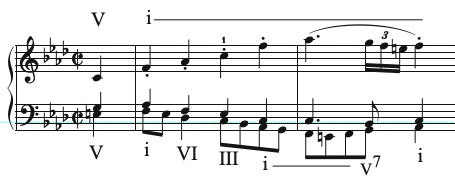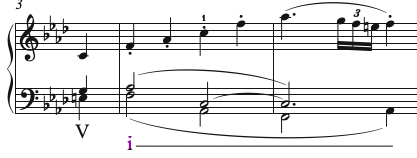Page 2 of 2
Re: A Question of Hearing and Notation in Beethoven
Posted: 11 Apr 2025, 04:24
by JJP
John Ruggero wrote: ↑10 Apr 2025, 12:08
Because of the leap of a fourth in the low register in all the examples, I do hear a root position dominant and then a root position tonic chord implied as if the C and following F were the bass voices for what follows.
Stylistically, for this piece, I can’t argue with your interpretation. It’s perfectly valid.
Perhaps because of my jazz background, I hear a melodic motion like that implying dominant to tonic harmony, but the expression of that harmony, particularly the dominant, is ambiguous. (It can potentially be harmonized in a variety of inversions.) The F minor arpeggio in the next bar more clearly implies a root position chord, but it’s not certain until the following bar when the left hand enters. For me that ambiguity is joyous, and part of what makes counterpoint so interesting. The overall harmony can be clear, but the specifics are ever shifting; sometimes decisive, sometimes ambiguous, based upon choice of pitch and rhythmic placement.
Careful manipulation of that clarity vs ambiguity is the art of the masters.

Re: A Question of Hearing and Notation in Beethoven
Posted: 11 Apr 2025, 06:50
by NeeraWM
John Ruggero wrote: ↑10 Apr 2025, 19:36
Thanks, Neera. Given the context, that staccato looks like an error to me, and I myself would play a slurred two-note group like the rest. The piece is nicely engraved, but I see a substantial error in m. 7 of your second example, so inaccuracy is not out of the question.
You are correct, John. A closer look at the MS shows that the missing slur is there. No matter how many times one goes through a source there are always new things to find.
Sorry for hijacking your post with this but could you point out what error you are seeing?
Thanks!
Re: A Question of Hearing and Notation in Beethoven
Posted: 11 Apr 2025, 13:50
by John Ruggero
That' s a fascinating point, JJP. I agree completely. In all styles of tonal music a single line melody can have all kinds of harmonic reinterpretation when another melody is counterpointed against it to create new secondary harmonies. For example:

- reinterpretation.png (44.88 KiB) Viewed 15819 times
But the new harmonies (shown below staves in the example directly above) are the result of passing motion within the tonic harmony (shown above the example) which provides the following framework:

- reinterpretation 2.png (36.04 KiB) Viewed 15542 times
So the harmony implied by the melody heard alone is still as valid as the new harmonization, each operating at a different level of structure. An improvisor (or composer) can seize on any melody as a basis for harmonic reinterpretation, but the melody on its own has a more basic internal structure that remains and organizes the reinterpretation.
Re: A Question of Hearing and Notation in Beethoven
Posted: 11 Apr 2025, 13:54
by John Ruggero
Neera, in m. 7 of your second example, it looks like the engraver misinterpreted the manuscript or ran out of room and couldn't fit the triplets in cello 1 over the correct notes in cello 2.
Re: A Question of Hearing and Notation in Beethoven
Posted: 11 Apr 2025, 20:28
by JJP
John, I laughed out loud at your first reharmonization using the triplet turn in the right hand as inspiration for the bass line. That’s cute.

For me, this ambiguity of harmonic specifics is what makes motivic or thematic writing powerful in skilled hands. You occasionally see this put to good use in stage and film scores when a motive returns with a different harmonization to illustrate a change in a character, setting, or other element.
I often enjoy this most when the theme seems simple or ambiguous when first presented, then later comes back with much more harmonic complexity that makes a listener reinterpret their initial assumptions about the harmony.
EDIT: I should also add that the first inversion V chord was one of the most likely options in my head as well! It’s not too demonstrative. Root position may feel too heavy in this case, but tastes vary!
Re: A Question of Hearing and Notation in Beethoven
Posted: 11 Apr 2025, 21:20
by John Ruggero
It's always so nice and "day-making" when someone "gets" something you've written, JJP, even a short musical example. Thanks! My first thought was an exact imitation, but then one runs into parallel octaves with the soprano. An inversion works so much better and allows the soprano and bass to exchange A flat and F. If this had been an actual arrangement, I would have put both passing eighth notes in the bass, the E flat and D flat, on the second quarter note, but wanted to make the passing harmony VI clearer for illustration.
I hear the effect you mention all the time in film scores. We watch a lot of British TV with their excellent background scores. The theme music is often adapted to all kinds of situations in very clever ways.
The first movement op op. 2 no. 1 is a powerful, stormy piece (although it is often played in a cutesy style that makes me cringe), and I think the initial upbeat definitely has the timpani quality that harpsi mentioned. When the key changes, however a legato inverted version of the theme appears in which the upbeat F flat is now only a decorative note and much less demonstrative:

- Beethoven op. 2 no 1.2 second part.png (569.97 KiB) Viewed 15214 times
Then he places the F flat squarely on the next downbeat and sf!
Re: A Question of Hearing and Notation in Beethoven
Posted: 28 Apr 2025, 20:40
by ttw
I always thought of the Beethoven opening as melodic and didn't think about harmony. After the discussion, I'd say that he's intentionally using (what may be analyzed) as an F minor arpeggiation with an F minor 64 leading to C (adumbrated with the E natural in the following triplet). When Beethoven came to a fork in the road, he took it.
Re: A Question of Hearing and Notation in Beethoven
Posted: 28 Apr 2025, 21:22
by John Ruggero
For me, the fact that the upbeat C comes on a weak beat and the forceful appearance of the root position I in m. 2 rules out any feeling of a I 6/4, as well as any feeling of V on the triplet. And I don't hear a I on the triplet in measure 4 either. Those secondary harmonies would have to be created by the addition of another melody as in the next-to-last examples above.
I suppose that one could maintain that those harmonies are "latent" in the melody, but then when would have to believe that every time the music goes up and down through three scale tones there is a latent I-V-I or V-I-V or whatever progression within it, and I don't think we hear it like that.
However one is in good company if one hears only a tonic harmony at the beginning of the piece. In fact, that is the way Heinrich Schenker analyzed it in his complete analysis of this sonata.